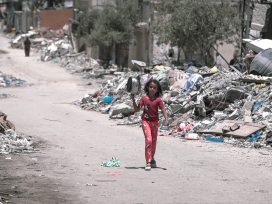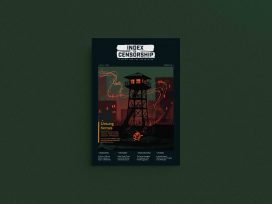The Israeli wall, far from being medieval, is an especially modern response, rife with the remains of Cold War obfuscation that viewed the world divided by the Iron Curtain as an essentially one-sided division.
Travelling along the old road from Jerusalem to Jericho one comes to an abrupt stop in the middle of Abu Dis, a village turned semi-suburb at the edge of Palestinian Jerusalem. A massive concrete wall rises eight-metres-high in the middle of the road, severing it; with no warning, the route is terminated. What was the centre of Abu Dis is now the frontier; shops that had been convenient to passers-by now struggle to stay in business; a petrol station is deserted. And ahead, the wall looms. The Hebrew and English graffiti reveals it as a podium for Israeli viewpoints, pro and con, object of an internal “conflict tourism”. A colleague tells me that on bringing a (rare) mixed group of Israeli and Palestinian university students to the site, the shamed Israelis cautiously examined whilst the Palestinians quickly posed together for photos, defiant, with fingers in “V” formation. Already this structure has become a perverse sort of monument. And it has been given a history, for chillingly, in large letters we read: “From Warsaw ghetto to Abu Dis ghetto”.
This row of prefabricated concrete segments is part of the Israel-Palestine “security barrier”, “separation fence” or “apartheid wall”; the nomenclature depends on your perspective. It is part of the lengthy structure that Israel claims will prevent suicide bombers from attacking its people. Whether this will have an effect is debatable, but more immediately, the wall has been used to consolidate Israeli settlements and to chop and fragment Palestinian land, imprisoning communities, separating farmers from fields and groves, cutting off people from their place of work, family from family and friend from friend. The wall is not an international boundary, but a division of two peoples that has been imposed by one, the Israelis, on the land of the other, the Palestinians. It joins a select group of similar structures – Berlin, Nicosia, Belfast quickly spring to mind – that in modern times have acted as radical physical separations in attempts to “solve” problems unresponsive to other means.
Not all walls still stand, and their circumstances have varied, from general condemnation of the East German policy for containment of its own citizens, to some voiced approval from both Protestants and Catholics for the “peace walls” in Belfast. The main section of the Israeli barrier will stretch somewhere between 300 and 600 kilometres long, and eventually wrap around the West Bank, whereas the Irish “peace walls” block individual streets, the most extensive along Springfield Road being about two miles in length. It would, however, be fair to say that all of these structures represent particular fault lines in human history and have been constructed expressly to separate and divide. In the more extreme cases, they have ruptured and sometimes imprisoned whole areas of habitation. Such walls are but one of the many horrors of war and occupation, yet in their particular tangibility, they can easily act as a focus for much that has gone wrong.
And yet, not all walls impose such draconian conditions, nor are all inherently bad. To some extent, our present understanding is conditioned by the modern study of the nature of borders. At the end of the nineteenth century, the new discipline of political geography began to distinguish between the relatively broad border region or fringe, and the borderline itself which was essentially an abstract line on a map. Such an observation spawned much ensuing interest and research into the culture of border areas; even more significantly, it is also a reflection on the idea that certain lines of division should never be fully realised. In some ways, this recalls practices of many centuries earlier; the Romans, for example, ploughed a furrow, usually circular and known as the poemerium, ritually to mark the extent of a new town. Under normal circumstances, the poemerium was only loosely echoed in the city walls, which deviated as necessary and were added to and changed over time to represent the practical structures of daily life; the result was an important but distant memory of the poemerium.
The point here is that walls both act symbolically and help to structure civic life, and while the two may intermingle, they are not necessarily the same. As much as ancient and mediaeval walls were necessary for defence, and certainly cities resembled fortresses, the wall had a constitutional role as well. One’s right to reside inside offered the freedom, and the responsibility, to participate as a citizen. At the same time, and more often than not, cities extended far beyond their walls, to include a hinterland of agriculture, seacoast, dependent villages, trading networks and sacred sites. Moreover, no city stood alone, and commerce, politics, friendship, cultural exchange and, yes, war, depended upon what lay beyond the walls. Gates were major landmarks, points of transition and links between inside and out. City gate cultures arose, and with them protocols of behaviour and interaction, some tacit and some explicit. For better or worse, as much as the wall demarcated and separated, it was also a means of connection and mediation.
Along with its symbolic content, the culture of the “thick'” wall as one that structures differences and transitions, thereby embodying and fostering a certain richness of meaning, has mostly disappeared. And yet, can we rid ourselves of walls? Probably not, for even in a globalised and electronically-linked world, the removal of all borders and bounds is hardly possible and, in fact, undesirable. Today some Berliners regret the total obliteration of the wall and wish to reinstate some form of demarcation as an acknowledgement that their unified city derives from both East and West. Clearly the need for remembrance is a driving force, but in addition, no one wants to live in a featureless and homogeneous world.
Identity normally requires some form of recognition or attachment to place which in turn depends on structure and differentiation. Beirut, which has had its own terrible divisions, and a “greenline” of death and destruction that has been referred to as a “stoneless wall”, has been facing these issues during its reconstruction. In recognition of the various communal groups that lay claim to the city, Lebanese sociologist Samir Khalaf suggests that there is a need for both intimacy and distance, malleability rather than confinement and exclusion. Permeability is crucial, where boundaries and motion exist in reciprocity. The static wall and the ability to traverse and transcend it are a key combination frequently ignored, and all too often, the imposition of separation structures is specifically intended to restrict unreasonably or eliminate passage. The wall is assigned a one-dimensional role and the control of movement becomes an insidious and primary weapon widely used in civilian conflicts. This produces a new type of topography, created by barriers and check-posts that remake the existing landscape and dominate every aspect of daily life, physical, psychological and symbolic.
It is frequently remarked that the Israeli wall is an astonishingly mediaeval solution for a modern problem; a heedless rejection of Montesquieu’s pronouncement that “with the invention of gunpowder, the impregnable place ceased to exist”. But beyond some atavistic hope for protection, the mediaeval comparison falls short, for this wall supports no mediated transitions that orient society, nor does it offer any means to articulate difference. It is a very thin wall indeed: a laceration that reinforces no more than the boundary. It has spawned only destruction, with the Israeli army demolishing all vegetation, buildings, and other forms of human presence along its path in the name of security. Clearly, whatever border region there could have been is being shattered, any hope of permeability that might allow and promote recognition and experience of the other side will soon be blocked. Rather than dredging up some residue of the pre-Enlightenment past, I would posit that this situation is an especially modern response. It is rife with the remains of Cold War obfuscation that viewed the world as divided by the Iron Curtain but relied upon the reality of that division as being essentially one-sided, so that either sector could imagine but never know the other.
This is not to say that both sides of the wall are always equal. The case of the Palestinians is particularly loathsome, for they suffer from Israel’s policy of containment and ghettoisation. For them, the visible side of the wall is viewed from a damaged and restricted interior. But for both sides, whether by volition or imposition, the wall is there to suppress all forms of engagement, violent, peaceful, or otherwise, so that for many there is a turning away and a removal of the conflict from the immediate consciousness to some darker depths from which it is bound to emerge ever more hideous. Such walls permit the populations behind them to grow horns. They foster a curious disengagement with reality, described in one Belfast study where they “allow people to see what they want to see on the other side, the image of their enemy.” In effect, the conflict becomes a representation of itself, spiralling into unrecognisable and uncontrollable permutations from its one and only side.
Human curiosity may sometimes provide the impetus to look beyond the wall, but too often, like the observation platform set up in Ledra Street of Greek Nicosia to peer into the Turkish sector, the result is literally a framed and constructed image; authentic experience of the other side becomes increasingly distant. It is not a surprise that next to the viewing platform, in a storefront, a nationalist museum was established. Strangely more provocative is the Turkish side, which remains a quiet backwater unknowing or uncaring of being observed. A small café is wedged in against the wall, and on this backdrop is painted a blank window. It is a tease, an image of an opening that points to the other side but goes nowhere and imparts nothing.
In Israel, the painting of walls is becoming common, a grim new art form perhaps. Along the new roads and motorways built as safe routes for Israelis to reach West Bank settlements, walls are erected at points of possible friction, usually when the road passes a Palestinian village or town. A solid concrete construction on either side of the Jerusalem-Modi’in Road is covered by a mural of a viaduct; through the arches the scene is painted with green meadows and blue sky. Flanked on both sides by this strangely imagined countryside, one speeds along the narrow and restricted road, wondering just who is being imprisoned here. A more distressing example is found on the wall just south of Jerusalem that separates Israeli Gilo from Palestinian Beit Jala. There, residents of Gilo gaze into a panorama that depicts a small village in the landscape, recognisably Arab in its topography and architecture but also reminiscent of something more ancient, almost biblical. The sun shines and the painted landscape is peaceful. But in this village there is no trace of people, it has been cleansed. The one-sided wall has become an image of delusion, beckoning to those who venture near to enter into its deceitful grip. And we can only strain to think what can be the way back from here.
Published 12 August 2004
Original in English
First published by Index on Censorship 2004
Contributed by Index on Censorship © Index on Censorship / Eurozine
PDF/PRINTNewsletter
Subscribe to know what’s worth thinking about.



